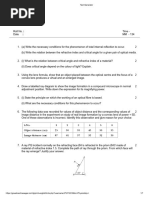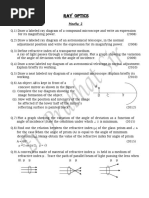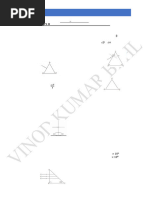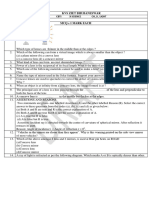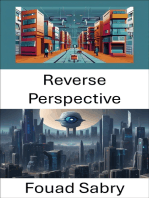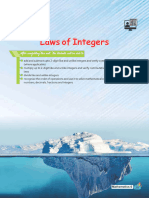Ray_Optics
Ray_Optics
Uploaded by
aheen.chatterjeeCopyright:
Available Formats
Ray_Optics
Ray_Optics
Uploaded by
aheen.chatterjeeCopyright
Available Formats
Share this document
Did you find this document useful?
Is this content inappropriate?
Copyright:
Available Formats
Ray_Optics
Ray_Optics
Uploaded by
aheen.chatterjeeCopyright:
Available Formats
Type of question and
Year Given question
marks
A converging beam of light travelling in air converges at a point P as
shown in the figure. When a glass sphere of refractive index 1.5 is
introduced in between the path of the beam,calculate the new
position of the image. Also draw the ray diagram for the image
formed
SAQ(3)
2019
A point ‘O’ marked on the surface of a glass sphere of diameter 20
cm is viewed through glass from the position directly opposite to
the point O. If the refractiveindexof the glassis 1.5,find the position
of the image formed. Also,draw the ray diagram for the formation
of the image.
SAQ(3)
A converging lens of focal length f1 is placed coaxially in contact
with a diverging lens of focal length f2 (f1 > f2). Determine the
SAQ(2)
power and nature of the combination in terms of f1 and f2.
How is the resolving power of a compound microscope
affected if
CBQ(2)-Analyze, evaluate (a) wavelength of light used is decreased, and (b) the diameter of
and create its objective lens is increased ? Justify your answers.
2020
(a)Using the necessary ray diagram, derive the mirror formula for a
concave mirror.
CBQ(3)-Analyze, evaluate (b) In the magnified image of a measuring scale (with equidistant
and create markings) lying along the principal axis of a concave mirror, the
markings are not equidistant. Explain
The refractive indices of two media A and B are 2 and
SAQ(2) respectively. What is the critical angle for their interface ?
2023
(i) Draw a ray diagram showing the formation of a real image of an
object placed at a distance 'u' in front of concave mirror 0f radius of
curvature 'R'. Hence obtain the relation for the image distance 'v' in
terms of 'u' and 'R'.
LAQ (5)
(ii) A 1.8 m tall person stands in front of a convex lens of focal
length 1 m, at a distance of 5 m. Find the position and height of the
image formed
2023
(i)Draw a ray diagram showing refraction of a ray of light
through a triangular glass prism. Hence, obtain the relation for the
refractive index in terms of angle of prism and angle of minimum
LAQ (5) deviation.
(ii) The radii of curvature of the two surfaces of a concave lens are
20 cm each. Find the refractive index of the material of the
lens if its power is -5.0 D
Assertion (A) : A convex lens, when immersed in a liquid,
disappears.
Assertion (A) and Reason Reason (R) : The refractive indices of material of the lens and the
(R) type questions (1) liquid are equal
The magnifying power of an astronomical telescope is 24. In normal
adjustment, distance between its two lenses is 150 cm. Find the
Short Answer type (2) focal length of the objective lens
Explain the following :
(a) For a simple microscope, the angular size of the object equals
the angular size of the image. Yet it offers magnification.
Short Answer type (2)- (b) Both plane and convex mirrors produce virtual images of
Application of knowledge objects. Can they produce real images under some circumstances ?
and concept
2024
(i) Trace the path of a ray of light showing refraction through a
triangular prism and hence obtain an expression for angle of
deviation (δ) in terms of A, i and e, where symbols have their usual
meanings. Draw a graph showing the variation of angle of deviation
with the angle of incidence. (ii) In the figure, a ray of light is incident
on a transparent liquid contained in a thin glass box at an angle of
Long Answer type
45 degrees with its one face. The emergent ray passes along the
Questions. (5)
face AB. Find the refractive index of the liquid
You might also like
- Workbook_RAY OPTICSDocument65 pagesWorkbook_RAY OPTICSharshita singhNo ratings yet
- 2024-12-17-0.4010822846883373 (3)Document26 pages2024-12-17-0.4010822846883373 (3)Sangeeta MittalNo ratings yet
- XII Q Group 3Document3 pagesXII Q Group 3Sanskriti VermaNo ratings yet
- 12 Ray Optics Assignment PDF.pdfdisplayName=12 Ray Optics Assignment PDFDocument3 pages12 Ray Optics Assignment PDF.pdfdisplayName=12 Ray Optics Assignment PDFsparshp703No ratings yet
- Test Ray optics sample paper 2016 2017 dated 050123Document2 pagesTest Ray optics sample paper 2016 2017 dated 050123Dragon GamingNo ratings yet
- Ten Years Board Problems CBSE 2018Document9 pagesTen Years Board Problems CBSE 2018Adhish MalhotraNo ratings yet
- Ray OpticsDocument6 pagesRay Opticsbehappy14662816No ratings yet
- CLASS TEST Ch 9Document1 pageCLASS TEST Ch 9ruchirverma20No ratings yet
- Ray Optics 24 AssDocument7 pagesRay Optics 24 Assmkhyati632No ratings yet
- Ray OpticsDocument6 pagesRay Opticsbehappy14662816No ratings yet
- MANISH SIR 9312441580: 5 Mark QuestionsDocument1 pageMANISH SIR 9312441580: 5 Mark QuestionsManish MishraNo ratings yet
- Ray Optics TheoryDocument4 pagesRay Optics Theoryshristyshukla16No ratings yet
- Physics- RAY OPTICSDocument24 pagesPhysics- RAY OPTICSkawinnidhi2008No ratings yet
- Ray Optics: Previous Years' Board QuestionsDocument5 pagesRay Optics: Previous Years' Board QuestionsRudra Sathwara100% (1)
- General Instructions: Section (A) : (1 Marks)Document2 pagesGeneral Instructions: Section (A) : (1 Marks)exploreharyanaNo ratings yet
- Ray Optics_01Document3 pagesRay Optics_01archamadevi3No ratings yet
- PP X WS1 ReflectionDocument5 pagesPP X WS1 ReflectionshreyangoesplayingNo ratings yet
- Class Test Class-Xii (Tutorial)Document3 pagesClass Test Class-Xii (Tutorial)Kousihk BoraNo ratings yet
- Wa0040.Document9 pagesWa0040.neoncrack23No ratings yet
- Phy Ch 5 WSDocument15 pagesPhy Ch 5 WSinfo.ssracademyNo ratings yet
- CONLIB LightreflectionAkey 20241021103931Document7 pagesCONLIB LightreflectionAkey 20241021103931juxtordinaryNo ratings yet
- Ray Optics With AnswersDocument5 pagesRay Optics With Answersaayushijha747No ratings yet
- Ray Optics - WS-1Document2 pagesRay Optics - WS-1bys628h8skNo ratings yet
- Ray Optics and Optical InstrumentsDocument20 pagesRay Optics and Optical Instrumentsswaroop007.godboleNo ratings yet
- Chapter 9Document16 pagesChapter 9aryanbaria535No ratings yet
- Physics - 1RT QP22Document5 pagesPhysics - 1RT QP2207CHRISTO SAVIO GEORGE 10CNo ratings yet
- CH - 9 Ray Optics PYQDocument41 pagesCH - 9 Ray Optics PYQhatagaledhammpalNo ratings yet
- Grade VII PhysicsDocument2 pagesGrade VII PhysicsMount Litera Zee SchoolNo ratings yet
- CBSE TEST PAPERS Reflection and RefractionDocument5 pagesCBSE TEST PAPERS Reflection and RefractionLomas GandhiNo ratings yet
- Worksheet - 2 Ray Optics and Optical InstrumentsDocument5 pagesWorksheet - 2 Ray Optics and Optical Instrumentssharmilarafi1501No ratings yet
- Ray Optics and Optical Instruments - Practice Sheet - VIJETA SERIES CLASS-12THDocument5 pagesRay Optics and Optical Instruments - Practice Sheet - VIJETA SERIES CLASS-12THNiraj Singh RohelaNo ratings yet
- QUESTION_BANK_RAY_OPTICS_and_OPTICAL_INSTRUMENTS_BY_KOMAL_CHHABRADocument2 pagesQUESTION_BANK_RAY_OPTICS_and_OPTICAL_INSTRUMENTS_BY_KOMAL_CHHABRAactivision.devanshduttaNo ratings yet
- Light Section B CompiledDocument41 pagesLight Section B Compiledshreyasarangi06No ratings yet
- PHYSICS SPIRAL XDocument40 pagesPHYSICS SPIRAL XShabnam ZakirNo ratings yet
- India.,: Sri ChaitanyaDocument22 pagesIndia.,: Sri Chaitanya8008.kailash.ssNo ratings yet
- G10 - Chapter Test 6 Ans - Ch.10 - 10 Nov 23Document12 pagesG10 - Chapter Test 6 Ans - Ch.10 - 10 Nov 23Urmila GNo ratings yet
- Revision Questions Set1-OpticsDocument5 pagesRevision Questions Set1-OpticsWilberforce JakiraNo ratings yet
- Ray Optics Question BankDocument16 pagesRay Optics Question Bankdhakshineashkg2007No ratings yet
- ACP - LightDocument9 pagesACP - Lightmedhanshraghavraju2007No ratings yet
- physics-class-xii-chapter-09-ray-optics-and-optical-instruments-practice-paper-09-2024Document6 pagesphysics-class-xii-chapter-09-ray-optics-and-optical-instruments-practice-paper-09-2024shamitaramesh9No ratings yet
- S5 Paper Ii Physics End of Term-YearDocument5 pagesS5 Paper Ii Physics End of Term-Yearlubangakene.francisNo ratings yet
- Cbse Light XDocument8 pagesCbse Light Xtristale9No ratings yet
- Ch-9 Light Reflection & RefractionDocument25 pagesCh-9 Light Reflection & RefractionBasit RasoolNo ratings yet
- Assignment (Ray optics ) for A.I S.S. C.E-2025Document4 pagesAssignment (Ray optics ) for A.I S.S. C.E-2025mahipriya1155No ratings yet
- Pyq's of Ray Optics and Optical InstrumentsDocument2 pagesPyq's of Ray Optics and Optical InstrumentsChavi PundirNo ratings yet
- Ray Optics WS 1Document9 pagesRay Optics WS 1PriyavasanthNo ratings yet
- Ray OpticsDocument38 pagesRay OpticsLavanya Sathya100% (1)
- Ilovepdf Merged PDFDocument48 pagesIlovepdf Merged PDFSomik JainNo ratings yet
- X - CH - 9 - Light-1Document19 pagesX - CH - 9 - Light-1nhbgytfrd4No ratings yet
- Light Revision Class 10Document34 pagesLight Revision Class 10karun.senthil.kumar.25No ratings yet
- Ray Optics 1Document2 pagesRay Optics 1mohithraganesan07No ratings yet
- Class 10 Study Material (Light - Reflection and Refraction)Document26 pagesClass 10 Study Material (Light - Reflection and Refraction)akshitajashNo ratings yet
- X - Science - Physics - CH-9 Light - Assignment-1Document2 pagesX - Science - Physics - CH-9 Light - Assignment-1Shweta DuhanNo ratings yet
- Physics 2023-24Document2 pagesPhysics 2023-24sofia khanumNo ratings yet
- New Ray and Wave 0ptics 24Document6 pagesNew Ray and Wave 0ptics 24misterunknown9585No ratings yet
- Lesson 5.1 LightDocument16 pagesLesson 5.1 LightRais RahimiNo ratings yet
- Class Xii Test 1 Ray OpticsDocument1 pageClass Xii Test 1 Ray OpticsAcademics AITNo ratings yet
- Optics and Optical Instruments: An IntroductionFrom EverandOptics and Optical Instruments: An IntroductionRating: 4 out of 5 stars4/5 (5)
- Reverse Perspective: Reimagining Visual Perception in Computer VisionFrom EverandReverse Perspective: Reimagining Visual Perception in Computer VisionNo ratings yet
- Lexington and Concord HSI (2) (2) (2) - 1Document3 pagesLexington and Concord HSI (2) (2) (2) - 1Mariah HarveyNo ratings yet
- 1926 NewmontBoddingtonGold Closure Plan2012Document156 pages1926 NewmontBoddingtonGold Closure Plan2012douglasnespoliNo ratings yet
- 3is Q2 Module 3 1Document23 pages3is Q2 Module 3 1Mary Joy JacilaNo ratings yet
- PERT - Nursing ManagementDocument18 pagesPERT - Nursing ManagementThangam jayaraniNo ratings yet
- Immediate download Putting Psychology in Its Place Critical Historical Perspectives 4th Edition Graham Richards ebooks 2024Document55 pagesImmediate download Putting Psychology in Its Place Critical Historical Perspectives 4th Edition Graham Richards ebooks 2024mantwgwendy100% (1)
- Trends Module 4 No ActivityDocument8 pagesTrends Module 4 No Activitygirlie jimenezNo ratings yet
- Hindi Type of QuestionsDocument2 pagesHindi Type of QuestionsAaditya MenonNo ratings yet
- storybrandDocument8 pagesstorybrandNitish Ranjan MauryaNo ratings yet
- TDW Form No. 02 - Thesis Dissertation Advising ContractDocument2 pagesTDW Form No. 02 - Thesis Dissertation Advising ContractDarwin TacubanzaNo ratings yet
- Immediate download Construction Planning, Equipment, and Methods 9th Edition (eBook PDF) ebooks 2024Document55 pagesImmediate download Construction Planning, Equipment, and Methods 9th Edition (eBook PDF) ebooks 2024talladhwibi100% (1)
- TN - Intro To SPM TechDocument16 pagesTN - Intro To SPM TechBala GopalNo ratings yet
- Cio 308 Data Sheet 4921240554 UkDocument11 pagesCio 308 Data Sheet 4921240554 UkVERY SYAYIDINANo ratings yet
- Selina Concise Physics Solutions Class 9 Chapter 7 Reflection of LightDocument30 pagesSelina Concise Physics Solutions Class 9 Chapter 7 Reflection of LightElite BrickmanNo ratings yet
- PMP TermsDocument62 pagesPMP TermsARVIND ARORANo ratings yet
- 34 Basic Rules of AlgebraDocument4 pages34 Basic Rules of AlgebraSana khanNo ratings yet
- Chapter 14 15e Lecture Slide HandoutDocument6 pagesChapter 14 15e Lecture Slide HandoutSamuel Owusu DonkoNo ratings yet
- AP Chemistry The Origin of Flame ColorsDocument2 pagesAP Chemistry The Origin of Flame ColorsNWong 63604No ratings yet
- Product and Company Identification: 04/15/2014 Revision: 01/27/2016 PrintedDocument5 pagesProduct and Company Identification: 04/15/2014 Revision: 01/27/2016 Printedmx401974No ratings yet
- Edie West - Frontier Nursing in Appalachia - History, Organization and The Changing Culture of Care-Springer International Publishing (2019)Document240 pagesEdie West - Frontier Nursing in Appalachia - History, Organization and The Changing Culture of Care-Springer International Publishing (2019)DINDA PUTRI SAVIRANo ratings yet
- Statistics and Prob TestDocument3 pagesStatistics and Prob TestjacobyvezfloresNo ratings yet
- Nursing Theories & Models Presentation: Johnson'S Behavioral System ModelDocument23 pagesNursing Theories & Models Presentation: Johnson'S Behavioral System ModelPriya bhattiNo ratings yet
- Avasthas of PlanetsDocument33 pagesAvasthas of PlanetsRajiv SalujaNo ratings yet
- ContouringDocument39 pagesContouringRenjith S AnandNo ratings yet
- Significance of EducationalDocument5 pagesSignificance of EducationallaumlokNo ratings yet
- IAS Mains Physics 2004Document9 pagesIAS Mains Physics 2004RATNADEEP BANERJEENo ratings yet
- Cheat Sheet StaticsDocument7 pagesCheat Sheet StaticsDiri SendiriNo ratings yet
- Creativity & Innovation:: PresentationDocument24 pagesCreativity & Innovation:: PresentationProf S P GargNo ratings yet
- Lesson Plan Q3 - Week1Document5 pagesLesson Plan Q3 - Week1Mary Jean Obiado100% (1)
- Maths 6 Solved ExcerciseDocument12 pagesMaths 6 Solved Excercisehorridhenry436No ratings yet
- Reinforced Concrete Structures by R Park and T PauDocument1 pageReinforced Concrete Structures by R Park and T PauSyafa Aqilla FadyaNo ratings yet








